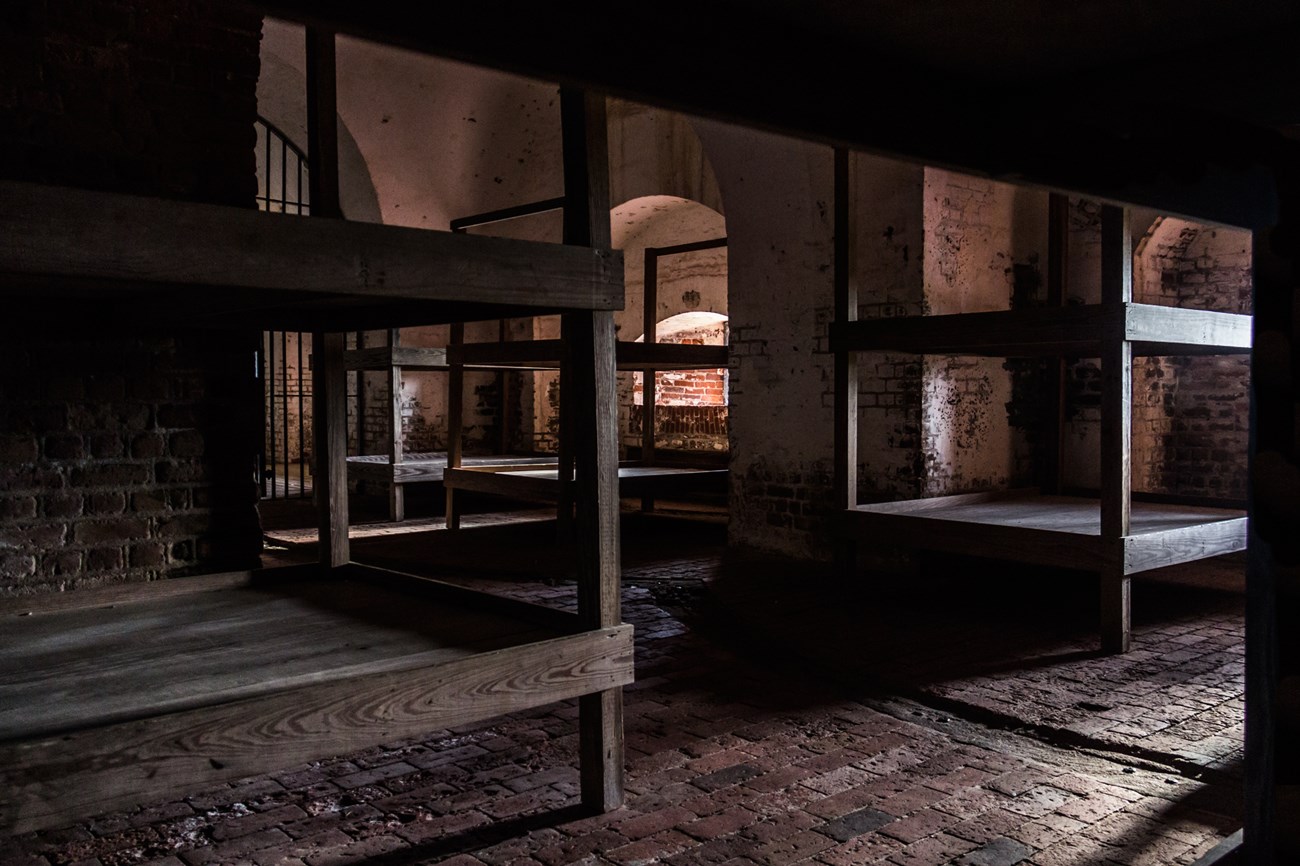Last updated: December 29, 2024
Article
Prisoner of War Experience

NPS/J. Cadoff
When the Civil War first broke out in 1861, few expected it to last beyond a few months. As the war dragged on, however, realities had to be faced, among them the question of what to do with prisoners of war. Over the first two years of the war, the prisoner of war experience was fairly limited. Most captured soldiers were held for only a few months before being released. One option for release was for the soldier to be paroled—temporarily released on the condition they remain in a certain area and not return to the war effort. Many officers were also exchanged—traded for an opposing prisoner of equal rank and returned to the war.
Everything changed in 1863. On January 1, 1863, President Abraham Lincoln issued the Emancipation Proclamation. All enslaved peoples held by states in rebellion were now free. The United States also began the enlistment of African American men into the military. This act enraged the Confederacy who accused the United States of “inciting service insurrection.” As the new United States Colored Troops (USCT) began reaching the front lines, the Confederate Congress issued the Retaliatory Act. This act declared that USCT units would not be treated as soldiers. Instead, Black soldiers would be handed over to state authorities where many would be sold into slavery. The white officers of these units, the act declared, were to be treated as inciting a slave rebellion and “shall, if captured, be put to death.”
With this act, the Confederacy officially refused to treat Black soldiers as combatants when captured. In response, the United States called for a cease of all prisoner exchanges until all soldiers were treated equally as prisoners of war. The Confederacy refused, thus beginning a shift in the prisoner of war experience. Suddenly, captured soldiers were being held long-term. Both sides had to create a system of large prison camps to house the thousands of prisoners of war.
Charleston
On April 12, 1861, the first shots of the American Civil War were fired in Charleston, South Carolina. Four years later, the city was still at the heart of the war. Beginning in 1863, Union forces gained a foothold on the islands surrounding Charleston Harbor. This effectively put the city under siege. Soon, the decision was made to bombard the city of Charleston itself. The United States sent a warning, urging civilians to leave, before opening a cannonade that would last for months.
Months passed by and the city continued to be bombarded. Major General Samuel Jones, the Confederate officer in charge, was desperate to end the firing. He requested that fifty US prisoners of war—all high-ranking officers—be brought to Charleston and confined in the section of the city under direct fire from US artillery. He hoped that this would bring an end to the firing. When word of this reached Union Major General John G. Foster, he retaliated in kind. He brought in fifty high-ranking Confederate officers and confined them under the Confederate’s artillery fire. Neither side was willing to relent first and neither side ceased their shelling. After several months of stalemate, President Lincoln allowed a one-time exchange for the Charleston prisoners.
After one hundred prisoners were exchanged, news reached Charleston that US General William T. Sherman was marching through Georgia on his way to Savannah. The Confederate government was fearful that he might reach the prison camp at Andersonville. Hundreds of prisoners of war, mostly officers, were moved to Charleston for safe keeping. Six hundred of these US prisoners were confined in a section of the city still under direct Union fire, just like the fifty before them.
Word of this soon reached Foster, believing that Jones had brought in yet more human shields. He ordered that six hundred Confederate officers be brought in. They were to be imprisoned on Morris Island, in direct line of fire from Confederate guns. The situation had worsened and this time there would be no exchange.
The Immortal 600
These six hundred Confederate officers represented each of the eleven seceded states, plus Kentucky, Maryland, and Missouri. Many of the men had been captured at well-known battles like Gettysburg, the Wilderness, Spotsylvania Courthouse, and Cold Harbor. Others had been captured at lesser-known places like Lancaster, Kentucky, Cumberland Gap, Tennessee, and Trevillian Station, Virginia. By the time they were sent to Charleston in the summer of 1864, many of the men had spent over a year as a prisoner-of-war.
Conditions on Morris Island in Charleston were not good. The prison consisted of an open-air stockade. Life was difficult with limited rations, poor shelters, and the constant exposure to artillery fire from their own side. For nearly three months, the stalemate continued. It wasn’t until yellow fever broke out in the city of Charleston that the Confederacy removed the US prisoners to newly erected prison camps further inland. With the US prisoners removed from Charleston, there was no need to keep the Confederate prisoners on Morris Island. With this realization, the next phase of their journey began. The Immortal 600 began the journey south, to Cockspur Island and Fort Pulaski.

NPS Photo
Fort Pulaski
On October 23, 1864, approximately 540 of the Charleston prisoners were marched into Fort Pulaski. The fort was hardly ready. The southeastern section of the fort—the same corner that had been destroyed during the battle in 1862—was chosen to house the prisoners. Several stoves were placed in the casemates and materials were provided for the prisoners to build their own bunks. No bars separated the prison from the rest of the fort when the prisoners first arrived, so the doors were kept closed and guarded constantly. Eventually, iron bars were put in place to truly designate the prison.
At first, their situation seemed to have improved. The casemates were damp and cold but far better than the tents and stockade of Morris Island. They were given slightly better rations, though still not enough to fully satisfy them. On top of that, their new guards—the 157th New York Infantry—treated them “with curtesy and respect” which was more than they had expected. In November, nearly two hundred of the prisoners were transferred to a prison camp on Hilton Head to help with the overcrowding issue. For those who remained at Fort Pulaski, life was about to get a whole lot worse.
In December 1864, word reached the US commanders in Charleston that the officer in charge of Fort Pulaski—Colonel Philip P. Brown—had disobeyed orders to place the Confederate prisoners on a starvation diet. When confronted, Brown claimed he had never received these orders and that he had simply done what he believed to be right. The orders were resent, and Brown saw no other option but to enforce them.
For a little over a month, the Confederate prisoners at Fort Pulaski were placed on a starvation diet in retaliation for mistreatments of US prisoners in Confederate camps. This diet lacked any meat, fruit, or vegetables, which led to an increase in diseases like scurvy, diarrhea, and dysentery. The prisoners were given no blankets or additional clothing. Many had to huddle together for warmth in the cold Savannah winter. Though they had been provided with stoves for cooking and heating, they were only given enough fuel for one, maybe two, fires a day.
“Hunger drove our men to catching and eating dogs, cats, and rats,” wrote Captain J. Ogden Murray. “Our men became as expert as cats at catching rats.” Captain George W. Nelson also recalled eating cats during this time. He also recalled an interaction with one of the US guards: “The last was a kitten—was tender and nice. A compassionate Yankee soldier gave it to me. I was cooking at the stove by the grating which separated us from the guard. This soldier hailed me: ‘I say, are you one of them fellers that eats cats?’ I replied, ‘Yes!’ ‘Well, here is one I’ll shove thro’ if you want it.’ ‘Shove it thro’,’ I answered. In a very few minutes the kitten was in frying order.”
By January 1865, a surgeon was brought in. He quickly ordered that the prisoners be given full rations and proper medicine, an order which probably saved many of their lives. For thirteen of the men, however, it was too late. Disease had claimed them, and they were buried in a small cemetery just outside the fort. For the remaining prisoners, life at Fort Pulaski continued with no end in sight.
Escape was constantly on the prisoner’s minds. Two men successfully escaped from the hospital by slipping out, stealing a boat, and rowing to freedom. Escaping from inside the fort was far harder, but that didn’t stop soldiers from attempting it. On February 26, 1865, Colonel Edward L. Molineux of the 159th New York—who took over for Colonel Brown in February 1865—recorded in his diary that:
“Last night some of the Confederate officers attempted a skillful but unsuccessful escape -- By working an old vent hole into the subterranean chambers they dug through another vent into the Commissary’s casemate, then by a rope dropped into the ditch swam the moat & eluded the sentries under cover of a dense fog. – They found the boats all guarded & were all recaptured – eight attempted it. –thin men who could squeeze through the holes. In consequence of this I have taken additional precautions & keep guard among them constantly & their quarters are visited daily & nightly every fifteen minutes by an officer.”

NPS Photo
After the War
Though this final escape attempt was unsuccessful, the prisoners would only have a few more days inside Fort Pulaski. During the first week of March 1865, the remaining Confederate prisoners boarded a steamer bound north for their final prison camp. Many were glad to be leaving the ordeal they had faced at Fort Pulaski. However, there was still uncertainty as they entered Fort Delaware for the final few months of the war.
By June 1865, the Civil War was all-but over. For those held prisoner, it was the moment they had been both waiting for and dreading. Finally, they could return home to their families, but first Confederate prisoners had to swear the oath of allegiance to the United States. “I have done the unspeakable,” wrote former Fort Pulaski prisoner Captain James L. Lemon on June 12, 1865, referring to taking the oath. “But I am now paroled & today set out for home.”
In the decades following the Civil War, soldiers began to publish memoirs and reminiscences to tell of their personal experiences during the war. Former prisoners-of-war joined in, and soon the stories of these prison camps began to spread across the reunited nation.
For those who had been imprisoned at Fort Pulaski, their experiences proved to be one of the more memorable of the war. The survivors called themselves the Immortal 600, and they formed their own little society to keep in touch with each other after the war. Several of the men published their diaries and memoirs. They even created a bronze medal that was given to the survivors in memory of their experiences.
Today, a small section of Fort Pulaski continues to show what these Confederate prisoners and their Union guard would have seen during those five months in 1864 and 1865. The original bars have long since rusted away, but reproductions provide visitors with just a small glimpse of what it was like during those five long months that Fort Pulaski served as a prison camp.
